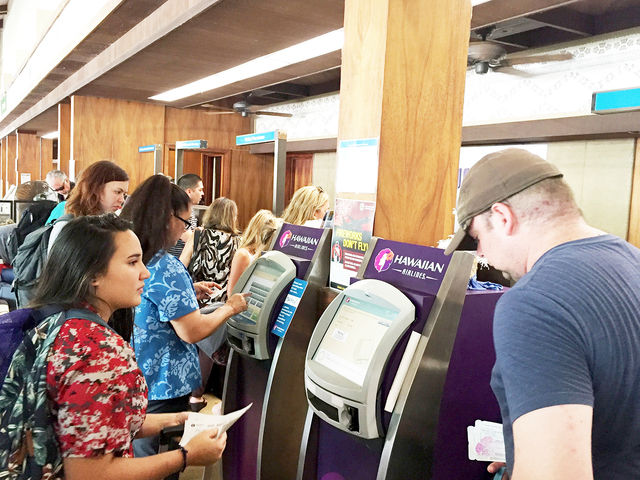LIHUE — Two days before Christmas and Lihue Airport was steady with people coming and going. Some were looking to visit neighbor islands or head to the Mainland. Visitors were coming to the Garden Isle for a tropical holiday vacation.
LIHUE — Two days before Christmas and Lihue Airport was steady with people coming and going. Some were looking to visit neighbor islands or head to the Mainland. Visitors were coming to the Garden Isle for a tropical holiday vacation.
Despite lines at the check-in counter and the TSA waiting area that were about 20 people deep, travelers and airport employees appeared in good spirits. Dozens of visitors exited the baggage claim area to a cool breeze and the warm Hawaiian sun on their faces.
Halley Knigge, Alaska Airlines spokesperson, said the week of Thanksgiving and the last two weeks of December are typically their busiest travel periods.
“We work to make sure our customers’ holiday travels are as stress-free as possible by making sure we have the right people in the right places at the right time,” Knigge said.
Patience is recommended for anyone traveling to be with family for Christmas.
“Airports are busier than usual, and tend to be filled with less-experienced travelers around the holiday season,” Knigge said. “That means lines are longer and move slower.”
Airlines are shifting the timing of thousands of flights, even adding dozens of redeyes, as they try to avoid delays while hauling millions of passengers from now through the Christmas weekend.
Success or failure could all depend on the weather and Mother Nature isn’t making it easy on airlines.
Rain and fog in the Northeast caused delays and cancellations Wednesday in Boston, New York and Washington — the busiest part of the country’s airspace. Rain in Chicago and Atlanta caused some delays in those cities too. Severe storms that ripped through Mississippi and Alabama, however, had little impact on air travel since no major airports are in those states.
Weather wasn’t the only culprit for travel headaches. A Black Lives Matter protest in Minneapolis clogged roads around the airport and temporarily blocked access to one of the two terminals. Passengers were moving through security again as of 4:30 local time.
There were about 5,300 delays and 430 cancellations around 8:15 p.m., according to flight tracking site FlightAware. That’s double the number of normal cancellations. The majority of flights canceled were smaller regional jets that carry 50 to 76 passengers. More than 28,000 flights were scheduled for Wednesday and a typical day sees about 150 cancellations and 4,000 delays.
The catch: flights are extremely full over the holiday period, with most travelers unable to make changes in their schedule.
Airlines expect about 38 million passengers over a 17-day period spanning Christmas and New Year’s, an increase of about 3 percent, according to an industry trade group, Airlines for America. The group says the average flight could be 90 percent full.
Crowds like that mean that any hiccup in the system — delays at a major airport, a technology glitch — can ripple across the country and leave tens of thousands of passengers standing in airport lines.
“The biggest factor is always weather,” said American Airlines spokesman Ross Feinstein.
Back-to-back storms led to more than 4,300 canceled flights around Christmas 2012. This time the Northeast corridor not only should be free of snow and ice, it should be relatively balmy with temperatures on Christmas Day in the 60s from New York to Boston. But rain and snow are forecast through Thursday in parts of the West, and the South and Ohio Valley could see severe storms before Christmas.
Airlines have been helped recently by the El Niño pattern that has brought above-average temperatures to northern states. “We saw that through the Thanksgiving holiday season, and we’ve seen that through November and December,” said Steve Hozdulick, Southwest Airlines’ managing director of operational performance.
United posted its lowest flight-cancellation rate ever for a Thanksgiving week, and Southwest had its best on-time performance ever for the day before the holiday, which helps reduce other problems such as lost or delayed bags.
From 9 percent to 19 percent of flights were delayed over the peak five-day Thanksgiving period, according to tracking service FlightAware.com. A year earlier, when the weather was worse, delays ran between 12 percent and 31 percent.
Besides the vagaries of weather, airlines in recent years have done a better job of adjusting schedules for peak holiday periods.
According to Mark Duell of FlightAware, U.S. airlines added up to 700 flights a day on Monday, Tuesday, Wednesday, Saturday and Sunday, compared with the same days last week. They cut about 4,400 flights on Christmas Eve and 5,700 on Friday, Christmas Day, when fewer people want to travel, he said.
Delta Air Lines and its Delta Connection affiliate scheduled 5,253 flights next Sunday, compared with fewer than 5,000 on a typical winter Sunday. Southwest expected Wednesday to be its busiest day, with more than 3,800 flights.
The peak day was last Friday for American, with 6,900 flights, and United, nearly 5,000, but both will also operate increased flights each of the next two Sundays.
Some of the additional flights are late at night, which gives travelers more options — and sometimes a lower fare. American and United successfully used the redeye tactic over Thanksgiving.


